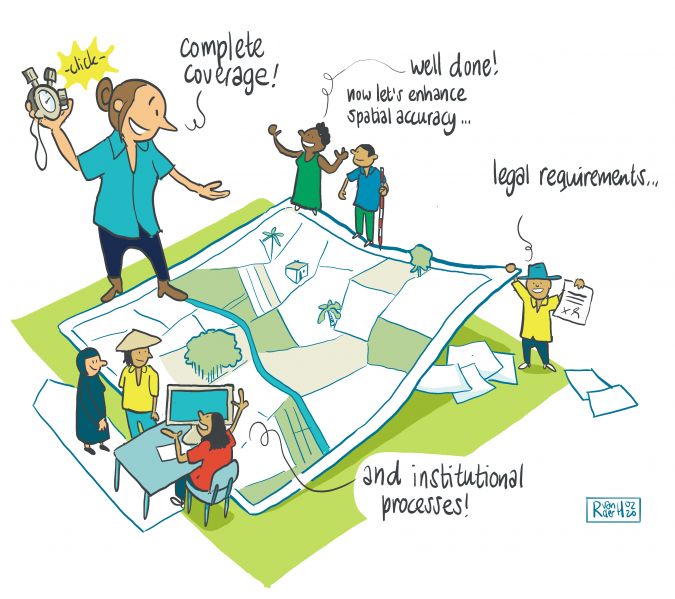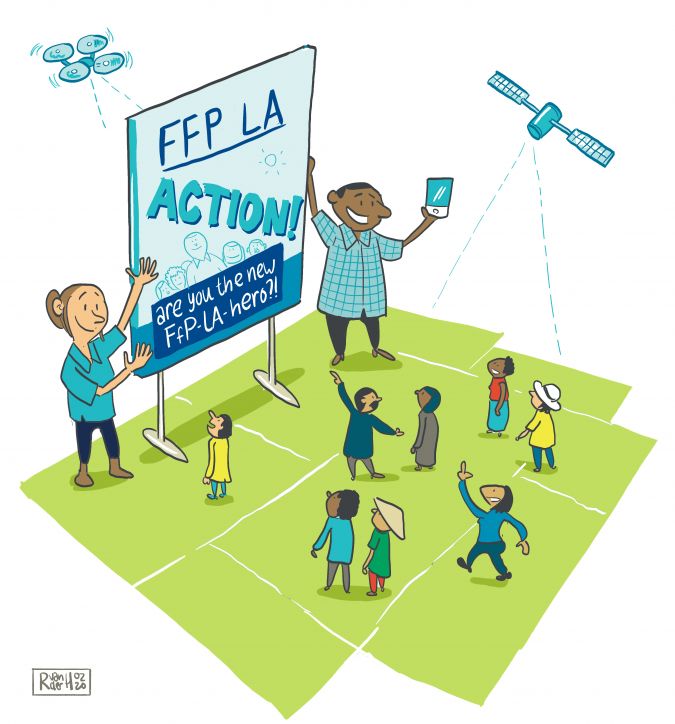Over the last decade, fit-for-purpose land administration (FFPLA) has developed into a viable philosophy with accompanying methodologies and tools for delivering land tenure security on a large scale. A new publication called 'Fit for Purpose Land Administration for All', which is backed by Kadaster International, suggests that FFPLA should be recognized as a once-in-a-generation opportunity for all stakeholders, and specifically for private surveyors.
The methodologies and tools of FFPLA contribute to large-scale land tenure in several ways: by encouraging participatory approaches, simplifying legal procedures, streamlining institutional processes and making use of innovative frontrunners and leading-edge technologies. The benefits of the approach have been proven in many country contexts and FFPLA has been backed by the World Bank, International Federation of Surveyors (FIG) and UN-Habitat, amongst other leading agencies.
The FFPLA methodology emerged due to the problems with existing land administration approaches. Cadastral mapping and land registration activities are often slow, expensive and reliant on a few skilled professionals. In many countries, this has resulted in just a very small percentage of land rights being formally recorded. This increases land disputes and uncontrolled development, decreases land productivity and may mean little or no government investment into land and infrastructure.

Whilst the benefits of FFPLA are now clear, it has still not yet become mainstream in many of the countries that need it most. FFPLA requires a whole-of-sector approach. In many countries, it is the role of the private sector to complete cadastral work. Although the need for FFPLA is often appreciated, private surveyors, lawyers, notaries, conveyancers and other land administration professionals rightly ask questions about its impact on job security and survey quality. Private surveyors were not involved in some FFPLA applications, and this highlighted the issue of stakeholder acceptance. For FFPLA to work in these countries, private surveyors also need to be on board. They must play a significant role in awareness raising, adoption, implementation and maintenance of FFPLA. The private sector is seen as essential for any level of scaled land administration in the developing world. Governments often lack the resources and technical capacity to sustain the land administration effort alone.
The work behind the new publication Fit for Purpose Land Administration for All, backed by Kadaster International, suggests FFPLA should be recognized as a once-in-a-generation opportunity for all stakeholders, and specifically for private surveyors. It maintains that, for those in the profession, FFPLA:
- Can mean more work and income, not less
- Will offer the opportunity to broaden professional horizons with the adoption of new technologies
- Presents opportunities for both undertaking and delivering new training
- Offers the opportunity to bring high-level technical leadership.
Moreover, the publication also busts a few myths, including by revealing that:
- Concerns over FFPLA accuracy and quality are hyped and misplaced
- Citizen confidence does not drop with the use of FFPLA
- Widespread FFPLA adoption can increase surveyor status and recognition
- Surveyors can play a role in raising awareness and helping to overcome legal and organizational blockers.
In many countries, many of the ingredients needed to make FFPLA a success are already in place. A willing, supportive and frontrunning surveying profession is essential. The new report also shows how, through the adoption of FFPLA, surveying professionals will be playing a direct and meaningful role in responding to major societal concerns. This includes direct support to climate change response, disaster risk management, women’s access to land, mass urban migration, overcoming conflicts and disputes, and the overall achievement of the 2030 Agenda and the Sustainable Development Goals (SDGs). In each case, the surveyor is a crucial community actor, delivering benefits to their community and raising the esteem of the profession… and all whilst doing business.

The publication provides guidance on pathways forward and support mechanisms for land sector professionals, including exposure to the global scene, key policies, agencies, resources and materials. A simple self-assessment for countries helps to show land administration professionals and related associations where their country stands in terms of FFPLA uptake, and what actions are needed. Initial actions range from self-education and awareness-raising to instigating pilots and financing. Further actions can include undertaking FFPLA work in the field, educating the next generation of surveyors and taking up the role of FFPLA champion to advocate it across regional and global domains.
What is fit-for-purpose land administration?
Fit-for-purpose land administration (FFPLA) means that land administration systems should be designed to meet the need of tenure security for all in a relatively short time and at a relatively low cost, adapting relevant legal, spatial and institutional frameworks accordingly. The aim is to achieve complete coverage and a complete overview first, and then improve incrementally over time, by enhancing spatial accuracy, legal requirements and institutional processes.
Further reading:

